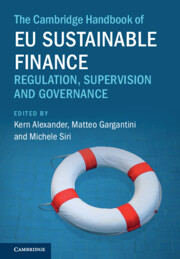Book contents
- The Cambridge Handbook of EU Sustainable Finance
- The Cambridge Handbook of EU Sustainable Finance
- Copyright page
- Contents
- Figures
- Tables
- Contributors
- Preface
- Acknowledgements
- Part I Introduction
- Part II Ethics and Sustainability in Corporate Law, Corporate Governance and Conduct
- Part III Integrating Sustainability in Financial Markets Regulation
- Part IV Ensuring Financial Stability and Sustainability
- Part V Financial Innovation and Sustainability
- 25 Can Financial Regulation Truly Support the Reduction of CO2 Emissions?
- 26 Climate Risk and Financial Markets
- 27 The Skin-in-the-Game Bond
- 28 Financial Innovation in the Process of Financial Inclusion
- 29 Sustainable Finance and Fintech
- Index
- References
29 - Sustainable Finance and Fintech
A Focus on Capital Raising
from Part V - Financial Innovation and Sustainability
Published online by Cambridge University Press: 30 January 2025
- The Cambridge Handbook of EU Sustainable Finance
- The Cambridge Handbook of EU Sustainable Finance
- Copyright page
- Contents
- Figures
- Tables
- Contributors
- Preface
- Acknowledgements
- Part I Introduction
- Part II Ethics and Sustainability in Corporate Law, Corporate Governance and Conduct
- Part III Integrating Sustainability in Financial Markets Regulation
- Part IV Ensuring Financial Stability and Sustainability
- Part V Financial Innovation and Sustainability
- 25 Can Financial Regulation Truly Support the Reduction of CO2 Emissions?
- 26 Climate Risk and Financial Markets
- 27 The Skin-in-the-Game Bond
- 28 Financial Innovation in the Process of Financial Inclusion
- 29 Sustainable Finance and Fintech
- Index
- References
Summary
Technology (especially the high energy-consuming blockchain) is not often associated with environmental goals but the elements of peer-to-peer networks, sharing economy and ‘direct’ finance in the Fintech world present coherence and continuity with the ESG world. Furthermore, the potential of Fintech in reducing costs, connecting people on a global scale, improving financial inclusion, diversification and resilience offer great opportunities also in the area of sustainable finance, advancing societal factors. Nonetheless, relevant risks and limitations must be considered, too. This chapter will first introduce the emerging area of sustainable digital finance, with particular regard to environmental objectives. Second, it will focus on ‘green Fintech’ facilitating capital raising. In particular, the chapter will analyse the main legal and technical challenges related to green financing, with special regard to green crowdfunding, green tokens offerings and other Distributed Ledger Technology (DLT)-based opportunities, also considering recent EU regulatory initiatives, also advancing some policy proposals.
Keywords
- Type
- Chapter
- Information
- The Cambridge Handbook of EU Sustainable FinanceRegulation, Supervision and Governance, pp. 743 - 776Publisher: Cambridge University PressPrint publication year: 2025

